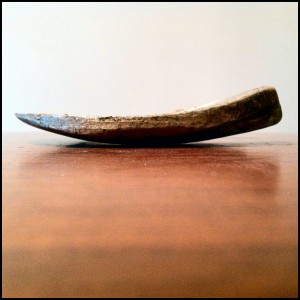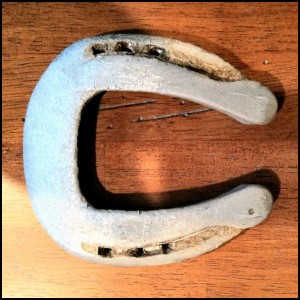When the owner led the horse out of the stall, my heart sank. This poor gelding was wearing a type of shoe known as a rocker, banana, or convex shoe, and although I’d read about them before, I’d never actually seen them “in action.” I wish I could have maintained that ignorance, because what a mess! This horse was among the sorest I’ve ever seen, and that includes a number of very-badly-foundered and injured ones. It was every bit as bad as what I’d imagined it would be; the horse had no sense of stability, and his entire body quivered with every step.
 When I read about this shoe in the American Farriers Journal quite a few years ago, the first thing that came to mind was, “What sort of person could think that anything about putting a rocking chair on the bottom of a horse’s foot makes sense?” I mean, you don’t have to be a genius (or even an engineer) to understand how illogical it is to try to walk on curved surfaces. Talk about being hard on joints – these things affect practically every joint in the horse’s body as he tries to stabilize something that’s inherently unstable. And, bearing in mind my observations about the direction of breakover noted in A Closer Look at Breakover, think about the torsion (twist) on those lower leg joints when there’s even a slight mismatch between the direction the shoe attempts to force the leg and the direction the limb naturally wants to take. Ouch!
When I read about this shoe in the American Farriers Journal quite a few years ago, the first thing that came to mind was, “What sort of person could think that anything about putting a rocking chair on the bottom of a horse’s foot makes sense?” I mean, you don’t have to be a genius (or even an engineer) to understand how illogical it is to try to walk on curved surfaces. Talk about being hard on joints – these things affect practically every joint in the horse’s body as he tries to stabilize something that’s inherently unstable. And, bearing in mind my observations about the direction of breakover noted in A Closer Look at Breakover, think about the torsion (twist) on those lower leg joints when there’s even a slight mismatch between the direction the shoe attempts to force the leg and the direction the limb naturally wants to take. Ouch!
 As I understand it, the intended purpose of this shoe is to allow the horse to “find” his most comfortable standing and walking hoof angle. Various “experts” advocate its use for horses with laminitis and “navicular,” as this particular horse was allegedly suffering from. Maybe, on a yielding surface such as soft dirt, shavings, or sand, the horse might be able to accomplish some degree of “angle adjustment” with shoes of this sort, although I would argue that the horse can accomplish exactly the same thing wearing flat shoes (or no shoes!). But on an unyielding surface such as concrete or hard-packed dirt, the horse’s foot ends up constantly rocking back and forth, alternately stressing the extensor and flexor tendons, as well as the suspensory ligament, as he attempts to stabilize his foot. So, at least on those types of surfaces, I would contend these shoes actually aggravate the problem rather than relieve it.
As I understand it, the intended purpose of this shoe is to allow the horse to “find” his most comfortable standing and walking hoof angle. Various “experts” advocate its use for horses with laminitis and “navicular,” as this particular horse was allegedly suffering from. Maybe, on a yielding surface such as soft dirt, shavings, or sand, the horse might be able to accomplish some degree of “angle adjustment” with shoes of this sort, although I would argue that the horse can accomplish exactly the same thing wearing flat shoes (or no shoes!). But on an unyielding surface such as concrete or hard-packed dirt, the horse’s foot ends up constantly rocking back and forth, alternately stressing the extensor and flexor tendons, as well as the suspensory ligament, as he attempts to stabilize his foot. So, at least on those types of surfaces, I would contend these shoes actually aggravate the problem rather than relieve it.
Of course, I would further argue that the entire notion of some unknown “correct” angle for a hoof is utter nonsense. I hear “angle” stuff all the time; owners want the hooves at a specific angle, or they want you to match the angles, or the vet tells them the heels have to be raised to accommodate some particular condition…on and on it goes. I’ll write more on this subject in the future because there’s such widespread misinformation about hoof angles, but in the meantime I’m here to tell you that except in incredibly rare circumstances, the correct angle for every hoof – regardless of the problem – is the angle that places the long & short pastern bones and coffin bone in proper alignment. When the bones are aligned through proper trimming, the tensions in the tendons are balanced, the hoof lands correctly, and the horse is at his most comfortable. There can be no “more correct” angle than this. And it’s no great mystery to figure out, either! So if you want to ensure the least strain on tendons and ligaments coupled with the best possible breakover, balance the hoof and don’t increase its length with a shoe – any shoe.
This horse continues to improve as his hooves begin to resume proper function. On the first follow-up visit, I saw a very different animal walk out of the stall. Although he still had some upper-body soreness, he wasn’t the complete mess I’d witnessed a few weeks earlier. And the owner paid me the highest compliment possible: “He’s moving so much better now! And, for the first time since I’ve owned him,” she remarked, “he’s actually happy!”
How can you beat that?